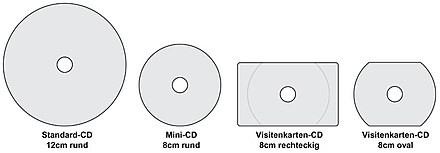Mini CD
![]()
The articles Single (music)#CD-Single and Mini-CD overlap thematically. Information you are looking for here may also be found in the other article.
You are welcome to participate in the relevant redundancy discussion or to help directly to merge the articles or to better distinguish them from each other (→ instructions).
![]()
The title of this article is ambiguous. The term Mini-CD is also used colloquially for an EP. The Mini-CD is not to be confused with the MiniDisc.
The Mini-CD has a smaller format with a diameter of 8 cm than the standard CD with 12 cm. When it was introduced in the late 1980s, it was intended for singles. After recordable CD-R/CD-RW came on the market in the 1990s, they were also offered in Mini-CD format. The capacity is usually 210 MB (equivalent to 23 minutes of playing time) or 185 MB (21 minutes).
The CD players manufactured before the introduction of the Mini-CD in the late 1980s, as well as players with slot-in drives and most CD changers, cannot play Mini-CDs. Therefore, there were special adapter rings that could be used to bring Mini CDs to the size of conventional CDs.

Overview of CD sizes
Marketing
In the late 1980s, the music industry moved to releasing singles on CD as well. For a while, some record companies relied on the mini-CD, which has about the playing time of a 12″ vinyl single played at 45/min. CD walkman (Discman) users were also targeted.
Most recently, there was an attempt to market singles in mini-CD format, in the German market from 2003 to 2005 under the name Pock it. The release of these CDs was a joint venture of the two major labels Sony Music and Universal Music. Almost all commercially successful singles released in Germany during this period were released as Pock it versions. These versions always contained only two tracks. However, these CDs were only moderately accepted by buyers, so that they largely disappeared from the market again from 2005 onwards.
Special formats
A special form is the business card CD (or business card CD), which is trimmed to the size of a business card on two or four sides. It is often used for advertising purposes. Such a CD has a capacity of 20 to 50 MB, depending on the manufacturer. There are also special formats with 100 MB. In contrast, the so-called "card.21" with 30 MB is already produced by injection moulding without milling.
Another special form are the free-form CDs or shape CDs. In this case, the CD is cut to an almost arbitrary shape. Such CDs should not be played in fast CD players, as they often do not run "round", i.e. with imbalance, and can therefore cause damage.
Search within the encyclopedia